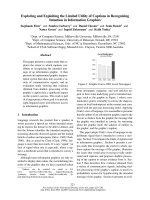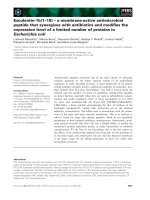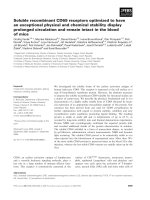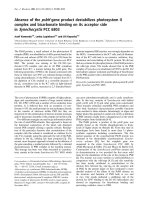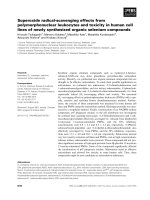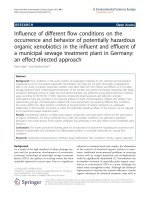Limited display of root vegetable organic product in co opmart cong quynh
Bạn đang xem bản rút gọn của tài liệu. Xem và tải ngay bản đầy đủ của tài liệu tại đây (2.86 MB, 79 trang )
UNIVERSITY OF ECONOMICS HO CHI MINH CITY
International School of Business
------------------------------
LE THI MY CHAU
LIMITED DISPLAY OF
ROOT VEGETABLE ORGANIC PRODUCT
IN CO.OPMART CONG QUYNH
MASTER OF BUSINESS ADMINISTRATION
Ho Chi Minh City – Year 2021
UNIVERSITY OF ECONOMICS HO CHI MINH CITY
International School of Business
------------------------------
LE THI MY CHAU
LIMITED DISPLAY OF
ROOT VEGETABLE ORGANIC PRODUCT
IN CO.OPMART CONG QUYNH
MASTER OF BUSINESS ADMINISTRATION
SUPERVISOR: Assoc. Prof. NGUYEN THI MAI TRANG
Ho Chi Minh City – Year 2021
TABLE OF CONTENTS
LIST OF FIGURES ........................................................................................................... 1
LIST OF TABLES ............................................................................................................. 3
ACKNOWLEDGEMENTS .............................................................................................. 1
EXECUTIVE SUMMARY ............................................................................................... 2
1. INTRODUCTION ......................................................................................................... 1
1.1 Introduction about Ho Chi Minh City of trading Cooperatives (Saigon Co.op)1
1.1.1 Saigon Co.op history and development ...................................................... 1
1.1.2 Saigon Co.op vision, mission, core value ................................................... 3
1.1.3 Organization chart ...................................................................................... 4
1.2 Introduction about Co.opmart supermarket chain ............................................ 5
1.2.1 Co.opmart background ............................................................................... 5
1.2.2 Co.opmart’s vision, mission, core values ................................................... 6
1.3 Co.opmart Cong Quynh, Agricultural Project Team and Co.op Organic product
.......................................................................................................................................... 6
1.3.1 Co.opmart Cong Quynh .............................................................................. 6
1.3.2 Agricultural Project Team .......................................................................... 7
1.3.3 Co.op Organic product and root vegetable category .................................. 9
1.4 Competitor’s analysis ...................................................................................... 11
2. SYMPTOMS ................................................................................................................ 12
3. PROBLEM ................................................................................................................... 15
3.1 Potential problems .......................................................................................... 16
3.1.1 Potential problem 1: Limited display root vegetable................................ 19
3.1.2 Potential problem 2: High price root vegetable ........................................ 22
3.1.3 Potential problem 3: Poor root vegetable product identification .............. 24
3.2 Problem validation .......................................................................................... 27
3.2.1 Problem validation: Limited display root vegetable................................. 28
3.2.2 Problem validation 2: High price root vegetable ...................................... 29
3.2.3 Problem validation 3: Poor root vegetable product identification............ 31
3.3 Main problem .................................................................................................. 33
4. CAUSE VALIDATION .............................................................................................. 33
4.1 Potential causes ............................................................................................... 33
4.1.1 Potential causes 1: Root vegetable is displayed in hidden corner ............ 35
4.1.2 Potential causes 2: Root vegetable organic is displayed small area ......... 36
4.1.3 Potential causes 3: Components of Visual Merchandising are not attractive
.................................................................................................................................... 37
4.2 Cause validation .............................................................................................. 38
4.2.1 Cause validation 1: Root vegetable is displayed in hidden corner ........... 38
4.2.2 Cause validation 2: Root vegetable organic is displayed small area ........ 42
4.2.3 Cause validation 3: Components of Visual Merchandising are not attractive
.................................................................................................................................... 43
4.3 Root cause ....................................................................................................... 45
5. ALTERNATIVE SOLUTION.................................................................................... 47
5.1 Alternative Solution 1: Adjust layout root vegetable category ....................... 47
5.2 Alternative Solution 2: Display combination root vegetable category ........... 48
5.2.1 Signage and educational materials ........................................................... 48
5.2.2 Product sampling ...................................................................................... 50
5.3 Justification of alternative solutions ............................................................... 51
6. ACTION PLAN ........................................................................................................... 52
7. SURPPORTING INFORMATION ........................................................................... 53
7.1 Secondary data ................................................................................................ 53
7.1.1 Organic market trend ................................................................................ 53
7.1.2 Potential driving forces for Vietnam ........................................................ 54
7.1.3 Major barriers for developing Vietnam organic market ........................... 54
7.2 Primary data .................................................................................................... 54
8. APENDIX A: Transcript of questionnaire ............................................................... 57
9. APPENDIX 2: Glossary .............................................................................................. 66
10. APPENDIX 3: Booming specialist organic stores in urban key cities.................. 68
11. REFERENCES .......................................................................................................... 69
LIST OF FIGURES
Figure 1: Saigon Co.op’s history and development ............................................................. 2
Figure 2: Saigon Co.op's business model and point-of-sale network .................................. 3
Figure 3: Saigon Co.op’s organization chart ........................................................................ 5
Figure 4: Co.opmart Cong Quynh’s organization structure ................................................. 7
Figure 5: The structure of Agricultural Project Team 2020 ................................................. 7
Figure 6: Saigon Co.op Private label hierarchy with sub-brand and Co.op Organic ........... 9
Figure 7: Portfolio of Co.op Organic by sub-category ....................................................... 10
Figure 8: Appraisal of the strategic management practices Co.opmart competitors ......... 11
Figure 9: The revenue Co.op Organic of Co.opmart Cong Quynh 2017-2020 ($VND) ... 12
Figure 10: The revenue Root vegetable of Co.opmart Cong Quynh 2017-2020 ($VND) . 13
Figure 11: Average bill value when customer buy root vegetable Co.op Organic ($VND)
............................................................................................................................................ 13
Figure 12: What are top 3 things you concern currently? .................................................. 14
Figure 13: Global organic sales 2000-2025 ($bn) .............................................................. 17
Figure 14: Revenue from 2017 to 2020 of Co.op Organic ($mil) ...................................... 17
Figure 15: Revenue from 2017 to 2020 of Co.op Organic divide by category ($mil) ....... 18
Figure 16: Display root vegetable product in Co.opmart Cong Quynh ............................. 20
Figure 17: Organic Food displayed in Co.opmart .............................................................. 22
Figure 18: Revenue fresh food of Co.op Organic period 2017 - 2020 ($mil)................... 22
Figure 19: Customer perception about food certification .................................................. 25
Figure 20: The Maslow’s pyramid demand........................................................................ 26
Figure 21: Preliminary cause and effect tree ..................................................................... 27
Figure 22: Lifestyle of today’s Vietnamese consumers about healthy life ........................ 30
Figure 23: Stages in the Buying process ............................................................................ 34
Figure 24: Updated Map ..................................................................................................... 35
Figure 25: Four different category roles in retail store ...................................................... 38
Figure 26: Classify customers buying Co.op Organic products by age ............................. 39
Figure 27: Layout Co.opmart Cong Quynh April 2021 ..................................................... 41
Figure 28: Using selling tool to display root vegetable with other fruits. .......................... 43
Figure 29: Point of sales material are not attractive ........................................................... 44
Figure 30: Bill value of customer buy Co.op Organic ....................................................... 45
Figure 31: The number of Co.op Organic product/ Bill value ........................................... 45
Figure 32: Example display root vegetable. ....................................................................... 50
LIST OF TABLES
Table 1: The number of SKUs Co.op Organic ..................................................................... 9
Table 2: Investment by types of ownership 2013-Prel.2019 (At current prices Bill. VND)
............................................................................................................................................ 15
Table 3: Classify food according to the language of the consumer. .................................. 21
Table 4: Compare with normal product and organic product. ........................................... 31
Table 5: Basket structure of Customer in 2020 .................................................................. 46
Table 6: Combined others solution..................................................................................... 51
Table 7: Implementation plan for alternative solution 1 .................................................... 52
Table 8: Qualitative Phase 1 – Initial Realization .............................................................. 55
Table 9: Qualitative Phase 2 – Problems Identification .................................................... 56
Table 10: Qualitative Phase 3 – Causes analysis ............................................................... 56
Table 11: Qualitative Phase 4 – Solution proposes ............................................................ 57
ACKNOWLEDGEMENTS
The International School of Business (ISB) was founded as part of University of
Economics Ho Chi Minh City (UEH) to provide a world-class, modern, and dynamic
educational environment. Participating in the MBA course in ISB was the time when I had
the opportunity to approach a professional education with learning methods and a close-tothe-point perspective of business operations. This is a valuable time to help me apply the
knowledge and skills which I have learned from the university, work experience applied to
situations, hypothesize, and more discuss with teachers. I had the opportunity to learn a lot
of knowledge, improve communication skills, teamwork, critical thinking, and most
especially problem solving.
First, I would like to express my most sincere thanks to lecturers of the ISB, who have
wholeheartedly imparted a lot of useful knowledge and lessons to me throughout the year
learning process at school. And it is also impossible not to express my sincere thanks to
Assoc. Prof. Nguyen Thi Mai Trang, she took the time to guide and help me a lot in the
process of completing this project. I would like to wish her family and her colleagues good
health as well as much success in your teaching and your future career.
During the period of doing this project, I received a lot of concern and guidance from
my colleagues at Saigon Co.op, Co.opmart Cong Quynh. I would like to send a heartfelt
thank you to them for helping me access knowledge, processes as well as related documents
and data about retail industry, Co.op Organic products, root vegetable in specific and
related information.
I would also like to thank my family and friends who have always supported,
encouraged me during completion of the project. Besides, due to certain limitations in
knowledge and not much actual contact time, the final project cannot avoid errors.
Therefore, I look forward to receiving your comments and suggestions to make this project
more complete. Once again, I am much obliged to lectures, colleagues working at Saigon
Co.op, my family and friends for enthusiastic supporting.
EXECUTIVE SUMMARY
This project “Limited display of root Vegetable Organic product in Co.opmart Cong
Quynh” is the in-depth research into the root vegetable Organic of Co.opmart Cong Quynh.
In terms of space: due to time constraints, the topic is limited in the scope of display
activities of Co.opmart supermarkets in Ho Chi Minh City emphasize Co.opmart Cong
Quynh with root vegetable case. In terms of time: the topic is conducted in the period from
January to May 2021, statistics always give priority to using the latest data, updated in the
end of 2020. For data that needs a comparison over the years, the oldest data from 2017
will be obtained.
Based on the findings previous sections and symptom of decrease revenue root
vegetable is caused by three potential problems: (1) Limited display root vegetable, (2)
High price root vegetable, (3) Poor root vegetable products identification. Following the
validation procedure, the third element was identified as the primary issue. Following that,
more investigation was carried out to identify three potential causes of the problem which
are: (1) Root vegetable organic is displayed in hidden corner, (2) Root vegetable organic is
displayed small area (3) Components of Visual Merchandising are not attractive. To resolve
this cause, solutions were proposed and develop a detailed implementation plan.
1
1. INTRODUCTION
1.1 Introduction about Ho Chi Minh City of trading Cooperatives (Saigon Co.op)
1.1.1 Saigon Co.op history and development
After the sixth National Congress of the Communist Party of Vietnam in 1986, the
country's economy shifted from subsidy to a socialist-oriented capitalist economy.
Cooperative economic model that was decades old. Vietnam experienced difficulties and a
massive crisis that had to be dissolved. In this situation, the People's Committee of Ho Chi
Minh City adopted a policy on May 12 1989, to turn the Management Board of the City
Buy and Sell Cooperatives into the Ho Chi Minh City Union of Cooperatives - Saigon
Co.op - which has two functions: doing business directly and organizing cooperative
movement. Saigon Co.op is an economic cooperative focused on the principles of collective
ownership, independent and self-responsible development, and business activities.
From 1992 to 1997, as the country's economy grew, foreign investment capital in
Vietnam made firms more active and inventive in seizing commercial opportunities and
learning from them with foreign partners' management expertise. To increase capital for its
growth path, Saigon Co.op began by forming joint ventures with foreign companies. The
strong growth of import-export operations, as one of the few units with direct import and
export licenses from the Ho Chi Minh Committee, resulted in high productivity, helping to
build the credibility and role of Saigon Co.op in domestic and foreign market.
During this period, the most striking event is the birth of the first Co.opmart
supermarket is Co.opmart Cong Quynh February 09 1996, with the help of the cooperative
movement international communes from Japan, Singapore and Sweden. Since then, a new
and civilized retail business model commensurate with Ho Chi Minh City's growth trend
has marked a new milestone for Saigon Co.op. The business has been and continues to
affirm its reputation over the past 30 years with many ups and downs along with the growth
of the country's economy. The retail market for domestic consumer products is becoming
highly competitive. With several new and modern retail models (Co.opmart, Co.op Food,
2
Co.opXtra, Co.opSmile, Cheers, Finelife, SC Vivo City, Sense City, HTV Co.op Home
Shopping, Co.op store, etc.).
Figure 1: Saigon Co.op’s history and development
(Source: Author synthesis from Saigon Co.op’s Website)
Saigon Co.op's retail sector has expanded significantly. It is the unit with the largest
market share in the domestic consumer goods retail market (41%) and is among the Top
200 retailers in Asia Pacific. The size and operating efficiency of Saigon Co.op has nearly
tripled, with an average annual revenue growth of over 25% (estimated to hit more than
33,278 billion VND by 2020), a budget payment of more than 200 billion VND, and the
creation of over 18,000 employees nationwide.
Saigon Co.op has supported the creation of network and distribution of merchandise
to 44 provinces and cities. At the end of 2020, the number of Saigon Co.op reaching nearly
1000 points of sale with 121 general merchandize supermarkets (Co.opmart), 437 Food
stores (Co.op Food), 4 hypermarket (Co.opXtra), 135 Co.op Smile, 39 Cheers, 03 Finelife,
4 Sense City, 130 convenience stores (Co.op store), 1 Ben Thanh store and 1 TV Home
Shopping site and other business model. Saigon Co.op retail system serving the shopping
and entertainment needs of over 1 million customers every day, in the spirit of economic,
3
social, and cultural development cooperation between Ho Chi Minh City and provinces as
well as cities across the country.
Figure 2: Saigon Co.op's business model and point-of-sale network
(Source: Saigon Co.op Financial Statement report 2020)
1.1.2 Saigon Co.op vision, mission, core value
Saigon Co.op vision is: “Trying to maintain position of the leading retailer in Vietnam
based on fast and stable development of Co.opmart supermarket series; exert to diversify
civilized and modern retail models; simultaneously strengthen the close relations with
4
customers and community; build Saigon Co.op to become a typical co-operative
organization with stature and operational scale in whole country, step by step extend in
international region; always be trusted and interested by partners”.
In order to achieve above vision, Saigon Co.op describes the mission as follows:
-
Meet the target customers’ daily needs,
-
Deliver convenience, safety, and additional value to customers,
-
Contribute to improve living standard of Vietnamese and the development retail
industry in Viet Nam.
Saigon Co.op’s core values also help companies to determine if they are on the right
path and fulfilling their goals by creating an unwavering guide with detail by: Satisfy
customers’ needs, Beloved home for employees and Contribute to community and
society.(1)
1.1.3 Organization chart
Saigon Union of Trading Cooperatives (Saigon Co.op) was founded in 1989 with
four industries about retail, investment, import – export distribution and production. In
order to operate, the management system of Saigon Co.op has member’s congress,
chairman, chief executive officer and five deputy managers. In particular, each deputy
manager will take responsibility for the precise department as well as some subsidiaries.(2)
The detail organization chart of Saigon Co.op is described as follow:
5
Figure 3: Saigon Co.op’s organization chart
(Sources: Author synthesis from Saigon Co.op’s capacity profile 2020 and Saigon
Co.op’s Website)
1.2 Introduction about Co.opmart supermarket chain
1.2.1 Co.opmart background
Co.opmart supermarkets were established, marking an important stage of
development: forming a supermarket chain under the “Co-op” branding Co.opmart. With
continuous development, up to now, the country has 113 Co.opmart supermarkets in many
provinces and cities, only in Ho Chi Minh City there are 40 supermarkets, some other areas
such as: the Southeast has 11 supermarkets, the North has 10 supermarkets, the Central has
14 supermarkets, the Southwest has 31 supermarkets, and the Central Highlands has 7
supermarkets.
Co.opmart has become a familiar brand, a reliable shopping place for people in the
city in particular and consumers in the country in general. The success of the Co.op
supermarket chain has brought Saigon Co.op to many noble awards, especially the award
"Top 500 excellent retailers in the Asia-Pacific region 2015" by Retail Asia Publishing
6
magazine voted. Saigon Co-op is the excellent Vietnamese retail brand representative to
receive the award "Vietnam's leading retailer Gold Award" and is also the first Vietnamese
company to be in the Top 200 list. Leading retailer in Asia-Pacific region in the 12-year
history from the date the award was first announced to date.
1.2.2 Co.opmart’s vision, mission, core values
-
Branding platform: Attach & share with conscientious service.
-
Vision: With conscientious service and desire to growth, Co.opmart affirms
"Leading Consumer Good Supermarket Brand" in Vietnam and develops to the
region, in order to bring the best benefits to customers and the community.
-
Commitment: Co.opmart close-knit and takes care of customers with dedication and
understanding, always strives to improve to bring satisfaction and practical benefits
to customers and the community.
-
Cultural values:
o Dedication to service: stemming from the passion for serving and deep
understanding of customers.
o Continuous improvement: constantly improving our products and services to
bring new experiences to customers.
o The desire to grow up: the desire to grow up towards perfection in order to
bring the most practical benefits to customers.
o Community oriented: always towards sustainable development in association
with the community's interests.
1.3 Co.opmart Cong Quynh, Agricultural Project Team and Co.op Organic product
1.3.1 Co.opmart Cong Quynh
-
Location: 189C Cong Quynh, Nguyen Cu Trinh Ward, Dist. 1, Ho Chi Minh City,
which is in the central commercial town in major roads and residential areas.
-
The numbers of employees: about 200 peoples
7
-
-
Target customer: Families or individuals that have middle - income or more with;
serve the main shopping trips with goods consumption from 2 to 3 days, mainly fresh
food, and staple products in area District 1, 3, 4, 5,10.
Totals store areas about 4,000 m2
Figure 4: Co.opmart Cong Quynh’s organization structure
(Soure: Human Resources Departement – Saigon Co.op, 2021)
1.3.2 Agricultural Project Team
Project Leader
Vice project
leader
Member
Member
Member
Figure 5: The structure of Agricultural Project Team 2020
(Source: Human Resources Department, 2021)
At the establish, the structure of Agricultural Project Team includes 1 leader, 1 vice
leader and some members. The project team advise the Board of Director on investment
8
orientation in each phase or all stages of the production chain, supply and distribution of
safe - high quality agricultural products for Saigon Co.op's retail system. Moreover, their
duty is the main contact point in planning, implementing, monitoring of project relates to
the project from the approval to executive. To more specific, build up marketing strategy,
research, coordinate with scientific organizations, partners with professional experience,
technology to looking for raw material areas, professional processes to the production
chain.
With the urgent need of the market as well as the appreciation of the potential
development of the organic food industry in the future, the protection of consumers' health
and food safety is the top concern of Saigon Co.op. Therefore, the company proactively
researched and searched for opportunities for cooperation and investment in organic
agriculture to bring the best real value to customers who are shopping at physical store of
Saigon Co.op. Saigon Co.op invests in farms (or cooperates with farmers), manages
production processes, builds distribution channels to sell Organic products to consumers.
In 2017, Saigon Co.op decided to launch a product line Co.op Organic to catch up
with the new consumer trend. The company officially put into business 4 groups of organic
foods branded Co.op Organic. Co.op Organic go to the business of this first batch includes
two types of Jasmine rice, Japonica rice, cucumber, squash, tomato, broccoli, water spinach,
Basa fish fillet and tiger shrimp. Business model of project from farm to consumer (end
users).
To carry out the project, the Agricultural Project Team was established with 01 vice
manager and 10 executives get direct guidance from deputy manager planning and quality
control. Although Co.op Organic is a Saigon Co.op’s brand, the operation of Agricultural
Project Team independence and parallel existence with Private Label Department which
responsibility for many brand such as: Select, Happy, Fineness.
9
Figure 6: Saigon Co.op Private label hierarchy with sub-brand and Co.op Organic
(Source: Author synthesis)
1.3.3 Co.op Organic product and root vegetable category
Co.op Organic are without chemical fertilizers, pesticides, growth stimulants,
preservatives or genetically modified ingredients meeting standards of the United States
Department of agriculture (USDA) and Europe.
Dept Name
Fresh Food
Packed Product
Others
Total
Table 1: The number of SKUs Co.op Organic
Sub-Dept Name
Number of SKUs
31
Vegetable
24
Root Vegetable
13
Seafood
7
Fruit
9
Rice
7
Broken rice, bran
91
10
Co.op Organic’s portfolio maintain stability 91 stock keeping units (SKUs) are
divided by fresh food, packed food and others (broken rice, bran). Vegetable and root
vegetable accounts for a high proportion respectively 34.1% and 26.4% in fresh food
department.
Broken rice, bran
Fruit
Rice
Seafood
Root Vegetable
Vegetable
0.0%
7.7%
7.7%
9.9%
14.3%
26.4%
34.1%
5.0% 10.0% 15.0% 20.0% 25.0% 30.0% 35.0% 40.0%
Figure 7: Portfolio of Co.op Organic by sub-category
(Source: Summary data from Corporate Planning Department-Saigon Co.op, 2021)
Fresh food category includes many sub-categories such as: broken rice, bran, fruit,
rice, seafood, root vegetable, vegetable. Fruits and vegetable are important part of healthy
diet. They provide important nutrition that restore and nourish the body’s cells.
In this project, the study focus on organic root vegetables to of Co.opmart Cong
Quynh. Organic root vegetables are underground plant parts eaten by humans as food
without chemical fertilizers, pesticides, growth stimulants, preservatives, or genetically
engineered components that satisfy US Department of Agriculture (USDA) and European
Union (EU) requirements. Organic root vegetables in Co.opmart Cong Quynh include 24
SKUs such as: carrot, cucumber, bell pepper, eggplant, organic melon, gourd, squash,
tomato, radishes, onions, etc. Root vegetables are categorized as vegetables whose
underground roots are edible. In addition to their nutritional benefits, these often-underused veggies can add colour and variety to your meals. Root vegetables are low in calories
and high in antioxidants. Root vegetables are still fresh whole foods that contain many
vitamins and minerals. Eating a variety of them is good for your health. (3)
11
1.4 Competitor’s analysis
In a current developing economy, Vietnamese consumers have higher incomes with
higher requirement and personalize experiences. Besides that, there are many “Big”
competitors not only in Viet Nam but also in foreign invested in this modern retail industry
with difference strategy to achieve competitive advantage such as: Vinmart, Lotte, Aeon,
Emart, Big C, etc. In Vietnam, organic products are still something new to consumers. But
the market is expected to emerge in the coming years, thanks to manufacturers’ push from
domestic to imported or self-produced Organic food, some suppliers in fast-moving
consumer goods (FMCG) can indicate such as: Vinamit, Vinamilk, TH True milk, etc. The
second reason depend on the role of media in communication and education through online
newspaper, social networks, media communication affect to consumer awareness. The third
is the support from retailers with booming specialist organic stores in urban key cities.
Big C
• Stores:36
(+1
compare
with 2018)
• Revenues: 2018
• 2-digit growth
• New Brand:
• BIG
C GO! & GO!
Market
•New Business :
• Shop-entertainment
•Strategy
• “Always low price”
Aeon
Lotte Mart
Vinmart
• Stores: 4
• Stores: 14 (+1
• Stores 127(+81%
• Revenues 2018 800
Million USD
• Plan: 20 shopping
center to 2025
• Increase experience:
new face, plus service
(Garden Terrace)
• Import goods suitable
for Vietnamese
people: Private label
compare with 2018)
• Revenues 2018-5,793
compare with 2018)
• Revenues : 2018 19.500
Billion VND, increase
Billion VND ( include
7.9%
Vinmart+)
• Plan: 60 shopping
center to 2020
• Increase online
experience: Speed L
• Environmental
protection activities:
Eco-Green, Eco-Bag
• Plan: 200 stores to 2020
• Rapid expansion strategy
(open or M&A), focus on
shopping center, Highclass residential area
• Increase customers
experience : VinMart 4.0,
Scan & Go
Figure 8: Appraisal of the strategic management practices Co.opmart competitors
(Source: Nielsen report, 2018)
12
2. SYMPTOMS
As interview with Mr. Van Luc – Director of Co.opmart Cong Quynh:
In recent years, revenue Co.op Organic of Co.opmart Cong Quynh is not good. The
revenue of Co.op Organic tends to be strong slow down. Although, revenue of Co.op
Organic accounts for a very small proportion of fresh food in specific and total
revenue of store in general, but organic product is the trend which consumers
concern when they are increasingly care about healthy. This is an issue that needs
attention to customers comeback to shopping as well as rebuy organic product.
According to Figure 9, when over view the revenue of total Co.op Organic category
Co.opmart Cong Quynh from 2017 to 2020, there has been a noticeable decrease revenue
from around 913 million VND to nearly 450 million VND.
1,000,000,000
900,000,000
800,000,000
700,000,000
600,000,000
500,000,000
400,000,000
300,000,000
200,000,000
100,000,000
-
913,310,109
901,775,883
723,940,799
449,842,420
2017
2018
2019
2020
Figure 9: The revenue Co.op Organic of Co.opmart Cong Quynh 2017-2020 ($VND)
(Source: Summary data from Corporate Planning Department-Saigon Co.op, 2021)
In addition, digging deeper into sub-category root vegetable, there is an obvious
decline the revenues of root vegetable organic of Co.opmart Cong Quynh from 2017 to
2020. For more detail, the sales from nearly 160 million in 2017 decrease more than 9 time
in 2020, the sales in this year only achieve about 17 million VND.
13
200,000,000
156,258,244
150,000,000
106,743,410
100,000,000
92,280,208
50,000,000
17,768,797
2017
2018
2019
2020
Figure 10: The revenue Root vegetable of Co.opmart Cong Quynh 2017-2020 ($VND)
(Source: Summary data from Corporate Planning Department-Saigon Co.op, 2021)
As response of Mr. Van Tong – Deputy Director Corporate Planning Department:
Nowadays consumer interest in this category is increasingly growing, owing to
rising health awareness and better product availability. As picture of revenue Co.op
Organic Co.opmart Cong Quynh, data collected from 2017 to 2020 showed that
average bill value of customer buy root vegetable Co.op Organic in trend of
decreasing. The bill value quite low, under 100,000 VND per bill.
60,000
55,139
53,062
50,000
40,707
43,218
40,000
30,000
20,000
10,000
2017
2018
2019
2020
Figure 11: Average bill value when customer buy root vegetable Co.op Organic ($VND)
(Source: Summary data from Co.opmart Cong Quynh, 2021)
14
In the other hand, the global market for organic food has developed significantly in
the past decade. There are many factors towards purchase intention of organic food
including genders, age, level of income, level of education and presence children in the
household. (4) As report of Kantar mentioned, a thorough understanding of the Organic
market that Viet Nam organic market has potential driving forces such as: rising health
consciousness, food safety and hygiene concern; higher disposable income and living
standards, emerging middle class; more foreign investment.
The first factor is rising health consciousness, food safety and hygiene concern. A
survey is conducted in 4 cities & rural Vietnam, top 3 things consumers concern currently
in turn are food safety (79%), disease, sickness (60%) and environmental pollution (42%).
Figure 12: What are top 3 things you concern currently?
(Source: Kantar Worldpanel |Lifestyle Survey |Urban 4 cities & Rural Vietnam, 2016)
The second potential is higher disposable income and living standards consumer has.
According to this report, by 2035 over half of Vietnamese will be in the global middle class,
consumers have higher income (income average monthly is expected to double in 2030
15
compared to 2016, increase from 4 million VND to 8.2 million VND per capita) so they
willing to pay for organic food.
Finally, according to General Statistics Office as illustrated in table 3 below, the
contribution to total investment capital for social development increase strongly. To be
more specific, investment foreign took up 21.9% of ownership structure in 2013 and this
value increased to nearly 23% in 2019. More foreign investment provides capital and brings
technology, management, marketing, providing opportunity for cultural exchange and
learning from developing countries in which organic food.
Table 2: Investment by types of ownership 2013-Prel.2019 (At current prices Bill. VND)
Foreign
State
Non- State
Total
invested sector
2013
441,924.0
412,506.0
240,112.0
1,094,542.0
2014
486,804.0
468,500.0
265,400.0
1,220,704.0
2015
519,878.0
528,500.0
318,100.0
1,366,478.0
2016
557,633.0
578,902.0
351,103.0
1,487,638.0
2017
596,096.0
677,900.0
396,200.0
1,670,196.0
2018
618,661.0
803,298.0
435,102.0
1,857,061.0
Prel. 2019
634,948.0
942,449.0
469,441.0
2,046,838.0
(Source: General Statistics Office)
Therefore, to understand clearly the situation category Co.op Organic in specific root
vegetable category of Co.opmart Cong Quynh, this project will research the symptom
completely in order to determine the fundamental problem and its core causes, as well as
to provide a feasible solution.
3. PROBLEM
The following steps have been taken to express the problem that occurs within the
Saigon Co.op Head Office, managers at Co.opmart Co.op Quynh store and customers by



